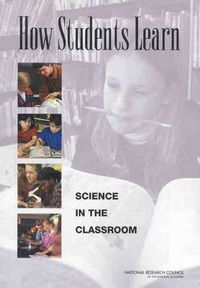
endast ny
How Students Learn
How Students Learn: Science in the Classroom builds on the discoveries detailed in the best-selling How People Learn. Now these findings are presented in a way that teachers can use immediately, to revitalize their work in the classroom for even greater effectiveness. Organized for utility, the book explores how the principles of learning can be applied in science at three levels: elementary, middle, and high school. Leading educators explain in detail how they developed successful curricula and teaching approaches, presenting strategies that serve as models for curriculum development and classroom instruction. Their recounting of personal teaching experiences lends strength and warmth to this volume. This book discusses how to build straightforward science experiments into true understanding of scientific principles. It also features illustrated suggestions for classroom activities. Table of Contents Front Matter 1 Introduction Part III SCIENCE: 9 Scientific Inquiry and How People Learn 10 Teaching to Promote the Development of Scientific Knowledge and Reasoning About Light at the Elementary School Level 11 Guided Inquiry in the Science Classroom 12 Developing Understanding Through Model-Based Inquiry A FINAL SYNTHESIS: REVISITING THE THREE LEARNING PRINCIPLES: 13 Pulling Threads Biographical Sketches of Committee Members and Contributors Index
Utgiven: 2005
ISBN: 9780309089500
Förlag: National Academies Press
Format: Häftad
Språk: Engelska
Sidor: 264 st
How Students Learn: Science in the Classroom builds on the discoveries detailed in the best-selling How People Learn. Now these findings are presented in a way that teachers can use immediately, to revitalize their work in the classroom for even greater effectiveness. Organized for utility, the book explores how the principles of learning can be applied in science at three levels: elementary, middle, and high school. Leading educators explain in detail how they developed successful curricula and teaching approaches, presenting strategies that serve as models for curriculum development and classroom instruction. Their recounting of personal teaching experiences lends strength and warmth to this volume. This book discusses how to build straightforward science experiments into true understanding of scientific principles. It also features illustrated suggestions for classroom activities. Table of Contents Front Matter 1 Introduction Part III SCIENCE: 9 Scientific Inquiry and How People Learn 10 Teaching to Promote the Development of Scientific Knowledge and Reasoning About Light at the Elementary School Level 11 Guided Inquiry in the Science Classroom 12 Developing Understanding Through Model-Based Inquiry A FINAL SYNTHESIS: REVISITING THE THREE LEARNING PRINCIPLES: 13 Pulling Threads Biographical Sketches of Committee Members and Contributors Index
Ny bok
463 kr487 kr
5% studentrabatt med Studentapan
Begagnad bok (0 st)
Varje vecka tillkommer tusentals nya säljare. Bevaka boken så får du meddelande när den finns tillgänglig igen.



